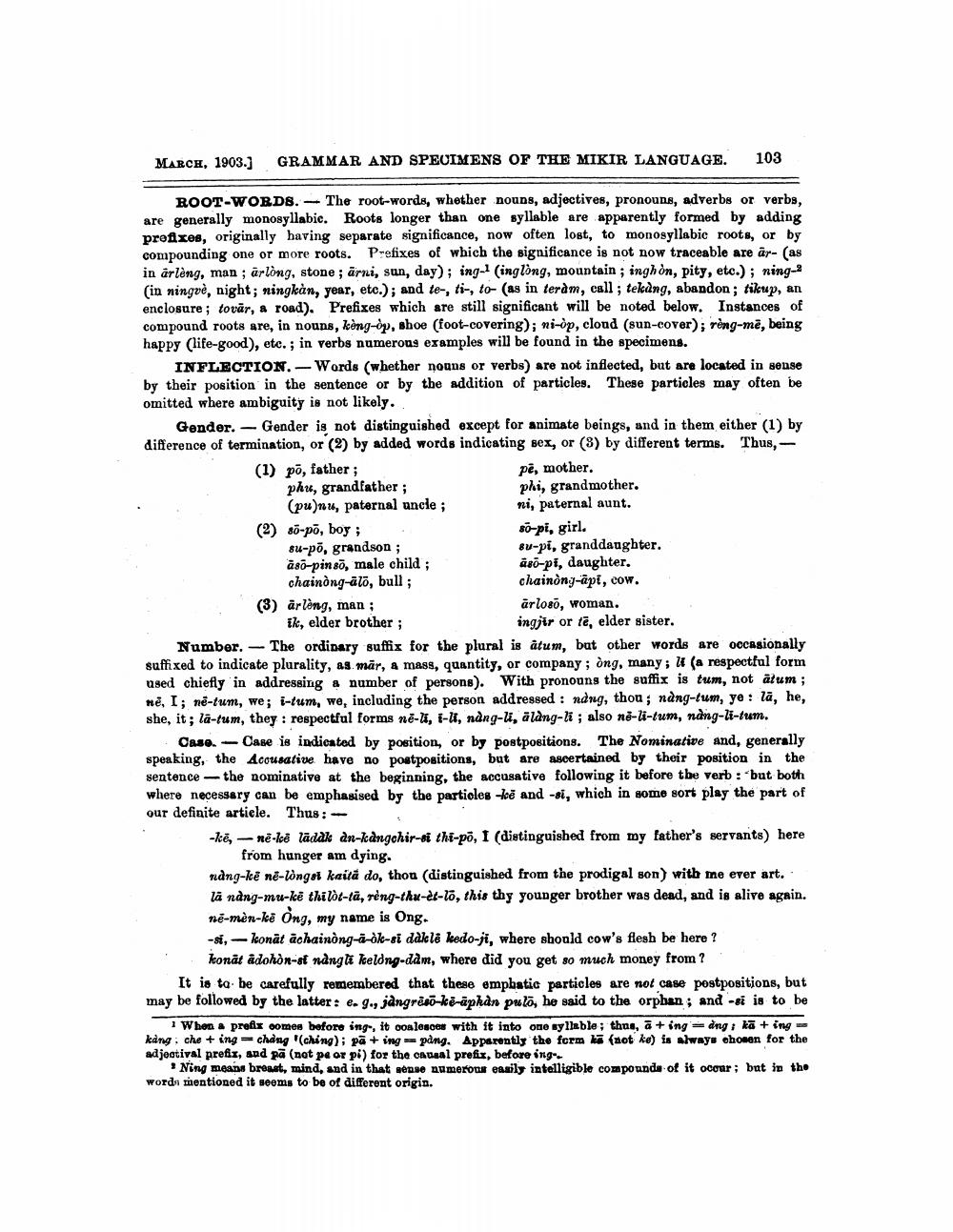________________
MARCH. 1903.]
GRAMMAR AND SPECIMENS OF THE MIKIR LANGUAGE.
ROOT-WORDS. The root-words, whether nouns, adjectives, pronouns, adverbs or verbs, are generally monosyllabic. Roots longer than one syllable are apparently formed by adding prefixes, originally having separate significance, now often lost, to monosyllabic roots, or by compounding one or more roots. Prefixes of which the significance is not now traceable are ar- (as in arlèng, man; ärlòng, stone; arni, sun, day); ing-1 (inglong, mountain; inghòn, pity, etc.); ning-2 (in ningvè, night; ningkàn, year, etc.); and te-, ti-, to- (as in teràm, call; tekàng, abandon; tikup, an enclosure; tovar, a road). Prefixes which are still significant will be noted below. Instances of compound roots are, in nouns, kèng-op, shoe (foot-covering); ni-op, cloud (sun-cover); rèng-me, being happy (life-good), etc.; in verbs numerous examples will be found in the specimens.
INFLECTION.-Words (whether nouns or verbs) are not inflected, but are located in sense by their position in the sentence or by the addition of particles. These particles may often be omitted where ambiguity is not likely.
Gender. Gender is not distinguished except for animate beings, and in them either (1) by difference of termination, or (2) by added words indicating sex, or (3) by different terms. Thus,
(1) pō, father;
-
phu, grandfather; (pu)nu, paternal uncle ;
(2) sō-pō, boy;
su-po, grandson; aso-pinso, male child; chainòng-alo, bull;
(3) ärlòng, man;
103
ik, elder brother;
pē, mother.
phi, grandmother. ni, paternal aunt. so-pi, girl.
su-pi, granddaughter. äsō-pi, daughter. chainòng-api, cow.
ārlosō, woman. ingjir or te, elder sister.
Number. The ordinary suffix for the plural is atum, but other words are occasionally suffixed to indicate plurality, as mär, a mass, quantity, or company; òng, many; l (a respectful form used chiefly in addressing a number of persons). With pronouns the suffix is tum, not atum; ne, I; ne-tum, we; i-tum, we, including the person addressed: nàng, thou; nàng-tum, ye la, he, she, it; la-tum, they respectful forms ne-li, i-li, nàng-li, alang-li; also ne-li-tum, nàng-li-tum.
Case.
Case is indicated by position, or by postpositions. The Nominative and, generally speaking, the Accusative have no postpositions, but are ascertained by their position in the sentence -the nominative at the beginning, the accusative following it before the verb: "but both where necessary can be emphasised by the particles -ke and -si, which in some sort play the part of our definite article. Thus:
-kē, -nē-kē tādāk an-kangchir-si thi-po, I (distinguished from my father's servants) here from hunger am dying.
nang-kë në-longsi kaita do, thou (distinguished from the prodigal son) with me ever art.
lā nàng-mu-kẽ thi lòt-tā, rèng-thu-et-lo, this thy younger brother was dead, and is alive again. ne-men-ke Ong, my name is Ong.
-si, konat ächainòng-a-ok-si dakle kedo-ji, where should cow's flesh be here ? konāt adohon-st nangli kelong-dam, where did you get so much money from?
It is to be carefully remembered that these emphatic particles are not case postpositions, but may be followed by the latter: e. g., jangrēsō-ke-aphan pulō, he said to the orphan; and -si is to be
1 When a prefix comes before ing-, it coalesces with it into one syllable; thus, a + ingang; kā + ing kang che+ ingchang (ching); pa+ ing pang. Apparently the form kā (not ke) is always chosen for the adjectival prefix, and pa (not pe or pi) for the causal prefix, before ing-.
Ning means breast, mind, and in that sense numerous easily intelligible compounds of it occur; but in the words mentioned it seems to be of different origin.




